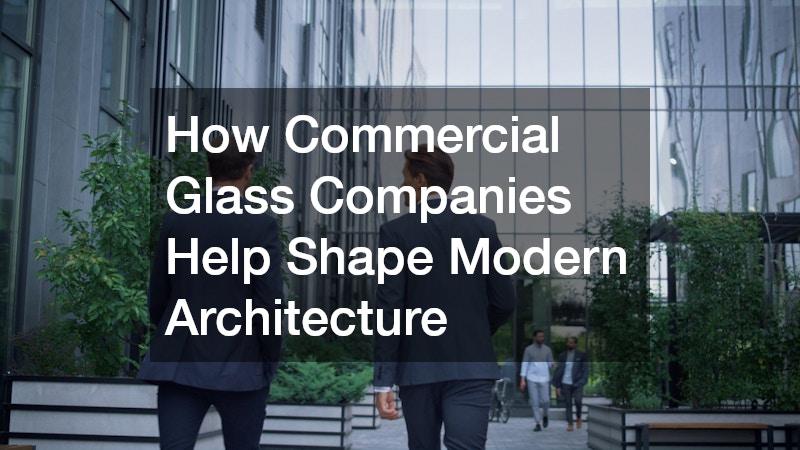In modern architecture, commercial glass companies are pivotal in transforming visionary ideas into tangible structures. They provide innovative designs that not only enhance aesthetic appeal but also contribute to the sustainability of buildings. The dynamic nature of glass has made it an essential component in contemporary structures, allowing for creative expression and functional benefits.
The Role of Commercial Glass Companies in Modern Architectural Design
Enhancing Aesthetic Appeal Through Innovative Glass Solutions
Commercial glass companies collaborate closely with architects to create bespoke glass products that define the beauty of modern buildings. By offering a vast selection of textures, colors, and finishes, they allow architects to explore creative possibilities that enhance both exteriors and interiors.
The result is a harmonious blend of art and functionality that brings architectural visions to life.
Glass companies push the boundaries of design by developing customized solutions that accommodate unique architectural requirements. Whether it is creating a breathtaking facade or intricate interior partitions, glass plays a crucial role in realizing architectural concepts. Creative use of frosted, tinted, and patterned glass increasingly sets contemporary buildings apart in urban landscapes.
Functional Aspects and Technological Advances in Glass
The functionality of glass extends far beyond its aesthetic qualities, contributing significantly to the performance of modern buildings. Technological advances in glass manufacturing have introduced features such as energy efficiency and enhanced safety measures. With options like double-glazing and laminated glass, buildings can achieve superior thermal performance and noise reduction.
Innovation in smart glass technology permits dynamic control over light and heat, improving energy efficiency and occupant comfort. These glasses can transition between transparency and opacity in response to environmental conditions, reducing the need for artificial lighting and temperature control. Safety aspects have also been improved with advancements like shatter-resistant and fire-resistant glass, enhancing the protection of building occupants.
How Commercial Glass Companies Contribute to Sustainable Architecture
Energy Efficiency and Environmental Impact
Commercial glass companies are at the forefront of sustainable architecture, primarily through the production of energy-efficient glazing solutions. By reducing the reliance on artificial lighting and HVAC systems, these solutions significantly lower the carbon footprint of buildings. This proactive approach not only helps in compliance with environmental standards but also aligns with the growing demand for green buildings.
Glazings such as low-emissivity and solar control glasses are designed to reflect heat and improve insulation, optimizing energy usage within structures. These technologies not only enhance the comfort levels within buildings but also contribute to substantial energy savings. Moreover, they demonstrate the commitment of glass companies to pioneering environmentally beneficial technologies that help combat climate change.
Recycling and Sustainable Manufacturing Practices
Commercial glass companies are increasingly adopting recycling and sustainable manufacturing practices to minimize their environmental footprint. Glass is one of the most recyclable materials, capable of being recycled indefinitely without loss of quality or clarity. This makes it an ideal candidate for sustainable building practices that prioritize resource conservation.
Many companies are now prioritizing the use of recycled glass in their products, reducing the need for raw material extraction. Sustainable processes such as using energy-efficient furnaces and water recycling systems further contribute to the reduction of environmental impact. These initiatives help in conserving natural resources, reducing waste, and lowering emissions associated with glass production.
How Commercial Glass Innovations Are Influencing Future Architectural Trends
Smart Glass Technologies and Their Applications
Smart glass technologies are revolutionizing future architectural trends by providing dynamic adaptability in building design. Capable of changing their properties based on environmental inputs, smart glass offers innovative applications such as energy efficiency and privacy control. This adaptation helps manage heat and light within a space, reducing reliance on traditional HVAC and lighting systems.
The implementation of electrochromic, thermochromic, and photochromic smart glass systems offers designers a tool to enhance energy performance without sacrificing aesthetic desires. With the ability to become opaque or transparent, these systems lend flexibility and control to building occupants. This customization enhances the user experience while contributing to the building’s sustainability objectives.
Integration of Artistic and Functional Design Elements
In modern architecture, the integration of artistic and functional design elements is increasingly facilitated by commercial glass companies. By blending vibrant artistic designs with practical functionality, glass provides a versatile medium for architectural expression. This combination of aesthetics and utility is a defining feature of contemporary building trends.
Architects and designers use glass to seamlessly integrate lighting, soundproofing, and temperature control with creative visual elements. Artistic glass treatments allow buildings to stand out, delivering both visual appeal and structural integrity. As the industry continues to innovate, glass remains a pivotal material in blending artistic aspirations with architectural needs.
Commercial glass companies have a profound impact on modern architecture, shaping its progression through significant advancements in glass technologies. Their contributions extend beyond aesthetics, driving sustainable practices and innovative design solutions that redefine contemporary building norms. As they continue to champion energy efficiency and creative collaborations, their influence on architecture will remain pivotal in constructing the sustainable and inventive buildings of tomorrow.


